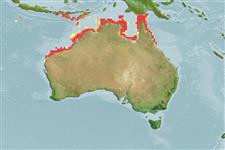>
Eupercaria/misc (Various families in series Eupercaria) >
Haemulidae (Grunts) > Plectorhinchinae
Etymology: Plectorhinchus: Greek, plektos = plaited + Greek, rhyngchos = snout (Ref. 45335); caeruleonothus: Name from the Latin words 'caeruleo' for blue and 'nothus' for bastard when combined as ‘Blue Bastard’ which has been commonly applied to this species by anglers for many years; referring to its blue sheen in life and difficulty to hook and land on artificial fly..
Environment: milieu / climate zone / depth range / distribution range
Écologie
marin récifal; profondeur 6 - 30 m (Ref. 103290). Tropical; 9°S - 25°S, 101°E - 147°E (Ref. 103290)
Distribution
Pays | Zones FAO | Écosystèmes | Occurrences | Point map | Introductions | Faunafri
Southwest Pacific: Australia (Western Australia toi Queensland).
Taille / Poids / Âge
Maturity: Lm ? range ? - ? cm
Max length : 100.0 cm TL mâle / non sexé; (Ref. 103290)
Description synthétique
Morphologie | Morphométrie
Épines dorsales (Total): 12; Rayons mous dorsaux (Total): 18-20; Épines anales 3; Rayons mous anaux: 6 - 7. This species is distinguished by the following features: D XII, 18-20 (rarely 20); A III, 6-7 (rarely III, 6); pectoral-fin rays 16-17 (usually 17); lateral-line scales 56-61 (modally 59); transverse scale rows above lateral line 15; gill rakers 7-9 + 18-20 = 25-29 (modally 26); in juveniles, pelvic fins reaching anus, slightly short of anus in adults; nostrils minute, 0.4-0.8 % SL, 2-3 times in distance from posterior nostril to eye; when fresh colouration in adults with body uniformly silver-grey, cheek and opercles blue-grey, rim of orbit and dorsal edge of maxilla dusky yellow, posterior margin of opercular membrane silver-grey, non-contrasting with remainder of opercle and adjacent body (Ref. 103290).
This species is found on sand, rubble and reef bottom but mostly in the intertidal zone, or shallow reef; one specimen trawled in a depth of 30 m. The most southerly record is a large individual estimated to be 100 cm in total length. Large individuals are most often solitary, foraging diurnally over relatively open expanses of soft substrate. Agonistic behavioural interactions have been recorded between individuals, individuals have often been observed to interact highly aggressively, engaging in one-on-one conflicts (Ref. 103290).
Life cycle and mating behavior
Maturité | Reproduction | Frai | Œufs | Fécondité | Larves
Johnson, J.W. and J.W. Wilmer, 2015. Plectorhinchus caeruleonothus, a new species of sweetlips (Perciformes: Haemulidae) from northern Australia and the resurrection of P. unicolor (Macleay, 1883), a species previously confused with P. schotaf (Forsskål, 1775). Zootaxa 3985(4):491-522. (Ref. 103290)
Statut dans la liste rouge de l'IUCN (Ref. 130435)
Menace pour l'homme
Harmless
Utilisations par l'homme
Plus d'informations
PaysZones FAOÉcosystèmesOccurrencesIntroductionsStocksÉcologieRégime alimentaireÉléments du régime alimentaireConsommation alimentaireRation
Noms communsSynonymesMétabolismePrédateursÉcotoxicologieReproductionMaturitéFraiRassemblement de ponteFéconditéŒufsDéveloppement de l'œuf
Taille/ÂgeCroissanceLongueur-poidsLongueur-longueurFréquences de longueursMorphométrieMorphologieLarvesDynamique des populations larvairesRecrutementAbondanceBRUVS
RéférencesAquacultureProfil d'aquacultureSouchesGénétiqueElectrophoresesHéritabilitéPathologiesTraitementNutrientsMass conversion
CollaborateursImagesStamps, Coins Misc.SonsCiguateraVitesseType de nageSurface branchialeOtolithesCerveauxVision
Outils
Articles particuliers
Télécharger en XML
Sources Internet
Estimates based on models
Phylogenetic diversity index (Ref.
82804): PD
50 = 0.5000 [Uniqueness, from 0.5 = low to 2.0 = high].
Bayesian length-weight: a=0.01380 (0.00670 - 0.02842), b=3.00 (2.83 - 3.17), in cm total length, based on LWR estimates for this Genus-body shape (Ref.
93245).
Niveau trophique (Ref.
69278): 3.9 ±0.6 se; based on size and trophs of closest relatives
Résilience (Ref.
120179): Très faible, temps minimum de doublement de population supérieur à 14 ans (Preliminary K or Fecundity.).
Fishing Vulnerability (Ref.
59153): High vulnerability (60 of 100).
Nutrients (Ref.
124155): Calcium = 21.8 [8.7, 40.3] mg/100g; Iron = 0.445 [0.233, 0.856] mg/100g; Protein = 19.4 [17.5, 21.3] %; Omega3 = 0.106 [0.058, 0.178] g/100g; Selenium = 36.5 [20.4, 62.3] μg/100g; VitaminA = 57.3 [21.5, 147.8] μg/100g; Zinc = 0.964 [0.681, 1.396] mg/100g (wet weight);
